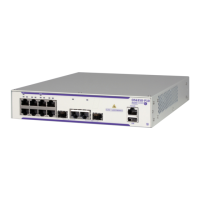DHCP Relay Commands
OmniSwitch 6250 CLI Reference Guide November 2009 page 32-45
ip udp relay vlan
Specifies a VLAN on which traffic destined for a UDP port is forwarded.
ip udp relay {BOOTP | NBDD | NBNSNBDD | DNS | TACACS | TFTP | NTP | port} vlan vlan_id
no ip udp relay {BOOTP | NBDD | NBNSNBDD | DNS | TACACS | TFTP | NTP | port} vlan vlan_id
Syntax Definitions
BOOTP BOOTP/DHCP well-known ports 67/68.
NBDD NBDD well-known port 138.
NBNSNBDD NBNS/NBDD well-known ports 137/138.
DNS DNS well-known port 53.
TACACS TACACS well-known port 65.
TFTP TFTP well-known port 69.
NTP NTP well-known port 123.
port A user-specified port that is not a well-known port.
vlan_id A numeric value (1–4094) that uniquely identifies an individual VLAN.
Use a hyphen to specify a range of VLANs (e.g., 1-5).
Defaults
N/A
Platforms Supported
OmniSwitch 6250
Usage Guidelines
• Use the no form of this command to remove the VLAN association with the UDP service port.
• The maximum number of VLANs that can receive forwarded UDP service port traffic is 256.
• Only specify service port numbers that are not well known when using the port parameter with this
command. For example, do not specify port 53 as it is the well-known port number for the DNS UDP
service. Instead, use the DNS parameter to enable relay for port 53.
• Specifying a VLAN for the BOOTP/DHCP service does not work if the per-vlan only forwarding
option is not active. Use the ip helper per-vlan only command to enable this option.
Examples
-> ip udp relay DNS vlan 10
-> ip udp 3047 vlan 500
-> no ip udp relay DNS vlan 10

